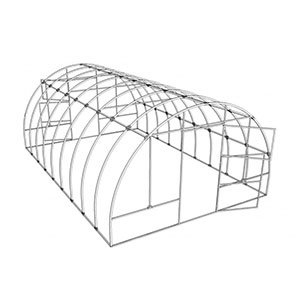Blueberry greenhouses can theoretically be used to cultivate other vegetables and fruits, but multiple factors need to be considered to ensure successful planting and maximize resource utilization. Below is a detailed analysis of planting other vegetables and fruits in blueberry greenhouses:
Light Requirements
Blueberries: Have relatively low light requirements and prefer shady and moist environments.
Other vegetables and fruits: Such as zucchini, require sufficient light for photosynthesis, which promotes plant growth and fruit development. Therefore, when planting other vegetables and fruits in blueberry greenhouses, attention should be paid to adjusting the lighting conditions to ensure they receive adequate light.
Temperature Management
Blueberries: Prefer growing in cool climates.
Other vegetables and fruits: Such as zucchini, prefer warm environments. Therefore, when planting other vegetables and fruits in blueberry greenhouses, it is necessary to maintain appropriate temperatures inside the greenhouse to avoid adverse effects from excessively high or low temperatures.
Soil Conditions
Blueberries: Like acidic soil.
Other vegetables and fruits: May have different soil requirements. However, generally speaking, the soil environment in a blueberry greenhouse will not have a significant impact on the growth of other vegetables and fruits, as long as reasonable management and adjustments are made.
Water Management
Blueberries: Have certain water needs.
Other vegetables and fruits: Such as zucchini, have varying water needs at different growth stages. Therefore, when planting other vegetables and fruits in blueberry greenhouses, it is necessary to conduct reasonable irrigation based on their growth stages and soil moisture conditions.
Planting Suggestions
Choosing Suitable Crops: When selecting other vegetables and fruits to plant in blueberry greenhouses, consider their growth cycles, light requirements, temperature requirements, and soil adaptability. For example, choose crops with staggered growth cycles from blueberries to fully utilize land and light resources.
Adjusting Greenhouse Conditions: Adjust the environment of the blueberry greenhouse according to the growth needs of the selected crops. For example, increase light intensity, adjust temperature and humidity, etc.
Reasonable Rotation and Intercropping: Through rotation and intercropping, land resources and nutrients can be fully utilized, and the occurrence of pests and diseases can be reduced. For example, after the blueberry growth cycle ends, short-term crops can be planted to restore soil fertility.
Strengthening Field Management: During the planting process, it is necessary to strengthen field management, including irrigation, fertilization, pest and disease control, etc. Through reasonable management measures, the yield and quality of crops can be improved.
In summary, blueberry greenhouses can be used to cultivate other vegetables and fruits, but adjustments to light, temperature, soil, and water management conditions are required. Through reasonable planting and management measures, the coexistence and prosperity of blueberries and other vegetables and fruits can be achieved, improving land resource utilization and economic benefits.
We specialize in the production of greenhouse accessories, want to know more about the product, please contact me.




